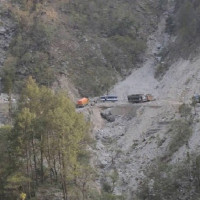- Friday, 4 July 2025
Where Lord Ram bathed and Markandeya conquered death
By Aashish Mishra,Lalitpur, Aug. 31: Such is the nature of Karma that even a sin committed while fulfilling one’s rightful duty is not forgiven. Ravan, as evil as he may have been, was a Brahmin. Thus, when Lord Ram killed him in the Treta Yuga, he had to bear upon him the sin of Brahman-murder (Brahma-Hatya).
So, to repent, he called all the great sages to his kingdom Ayodhya. The revered Rishi Agastya, though, did not go. He could not have Ram’s audience while he remained a sinner. But he also felt obligated to help cleanse the seventh incarnation of Lord Vishnu of his offences.
Agastya advised Ram to travel to the Lalitaranya Forest and bathe in a pond where he had summoned the waters from 10 million pilgrimage sites (Koti Tirtha). Lord Ram did as instructed.
Just as Kathmandu has the Sleshmantak Forest around Pashupatinath, Lalitpur had the Lalitaranya Forest around present-day Kumbeshwor, informed Madhav Shyam Sharma, priest of the Sarveshwor and Kumbeshwor Mahadev on the premises of the Bagalamukhi Temple. The Koti Tirtha pond in which Ram took a dip is believed to be the Konti Pond in the same Bagalamukhi complex.
Sharma also shared another story.
The Kiranti king Patuka had a daughter who unfortunately struck with leprosy. As a result, she was shunned by everyone in her family. They mistreated her and eventually chased her out of the palace. She was forced into the Lalitaranya Forest where, as luck would have it, she discovered a pristine pond.
Every morning, she would wash herself with its water and pray at the Shiva shrine located nearby. The pond was divine and the princess’s heart was pure. So, with each bath, she began to heal and after some time, she achieved a divine form. She was more beautiful than anyone in the land.
Seeing this, her family invited her back. But she did not want to return to people who had rejected her in her time of need. She spent her whole life in the forest, in devotion to lord Shiva, and attained liberation on the pond’s shores.
The holy pond that cured the princess of her leprosy is considered to be today’s Konti Pond.
Konti Pond still exists today, a few steps from the Sarveshwor Mahadev Temple in the aforementioned Bagalamukhi complex. But for most of the year, it exists as a stone water fountain Hiti. It is only for Janai Purnima, which this year is on Thursday (today), that the water is allowed to pool and turn the conspicuous quadrangular hole in the ground into a proper pond.
Sharma informed that the water that flowed from the Hiti and collected in the pond at Konti was believed to be water from the holy Gosaikunda lake. “So, people who cannot go to Gosaikunda on Janai Purnima can come here for merit.” Even those who do go must come here afterwards with the sacred site’s Jal (water). The pond is also important for Kirants as Kiranti shamans are required to visit Konti every year to renew their numinous utterances (Mantra).
The evening before Janai Purnima, the elaborate crown, or rather shell, of the Sarveshwor Mahadev featuring cobra deities (Nag) is also placed on a seat built in the middle of the pond.
Sarveshwor is an important deity in his own right. Housed in Patan’s five-storeyed temple, the Mahadev blesses his devotees with sound health and long life. As Sharma said, even the moon came to this holy site and meditated to rid himself of ailments.
According to Sharma, Sarveshwor Mahadev is one of the 64 Jyotirlingas and is also associated with the legend of Rishi Markandeya, one of the eight immortals (Asta Chiranjeevis). Markandeya was born with a short life and was supposed to die before he completed his teens. So, on the advice of his father Rishi Mrikanda, he came to the place that is today Lalitpur and devoted himself to the service of Sarveshwor.
Soon, the day of his death arrived and Yamaraj came to take him to the afterlife. But Markandeya asked him to let him complete his Mahadev Puja first. At first, Yamaraj agreed but as the Puja ran long, he lost his patience and threw his lasso to snare Markandeya and take him by force. This frightened the Rishi and he hugged the Shiva Linga he was worshipping.
Just then, Shiva appeared and was ready to punish Yamaraj for trying to kill his devotee while he was praying. Yamaraj begged for forgiveness and left and Markandeya got the boon of immortality. “You can still see where Yamaraj threw his noose and where Markandeya placed his arms from markings on the Sarveshwor Shiva Linga,” Sharma shared, showing the marks on the stone phallus.
Because Sarveshwor Mahadev helped his worshipper conquer death, he is also revered as Mrityunjaya Mahadev. Just as the Arya Ghat is the primary Ghat associated with Pashupatinath, Shankhamul Ghat is the principal Ghat for Mrityunjaya Mahadev, which is why it too has acquired the name Mrityunjaya Ghat.
“How did Sarveshwor come to be known as Kumbeshwor then?” this journalist asked.
“Oh, he did not. Kumbeshwor is a separate Mahadev shrine,” Sharma responded, showing a smaller Shiva Linga behind the Sarveshwor shrine. “This is Kumbeshwor Mahadev.”
As a Jyotirlinga, Sarveshwor Mahadev originated itself while Kumbeshwor was consecrated by Rishi Agastya through the water collected in a pitcher (Kalash/Kumbha). Hence the name.
The Konti Pond and the Sarveshwor Mahadev temple both hold great historical and religious significance. But the state does not seem to have realised this fact . Sharma believed that the temple once had hundreds of Ropanis of land to sustain it. “But we don’t know where they are now or even if they still exist?” he said.
Similarly, for managing the temple’s daily worship, the Guthi Sansthan provides Sharma with a meagre Rs. 18 per year. That is less than 5 paisa per day. Besides, he gets four Muris (approximately 256 kilograms) of rice as Khanki.
“We do not even have an identity card,” Sharma complained. “This created problems when we had to come to the temple during the COVID-19 lockdown.”
















